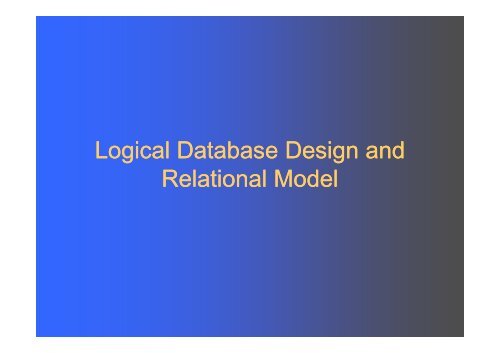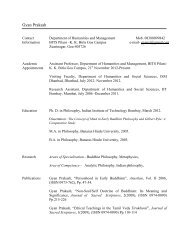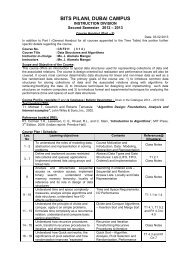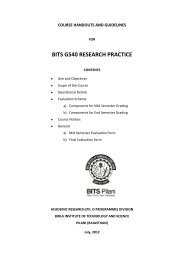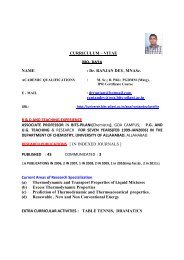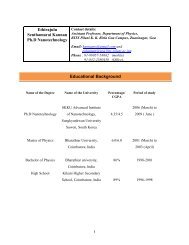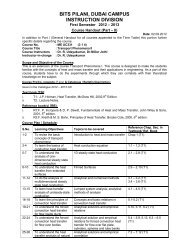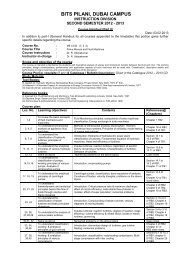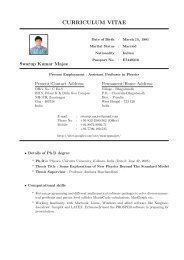relation
relation
relation
Create successful ePaper yourself
Turn your PDF publications into a flip-book with our unique Google optimized e-Paper software.
Logical Database Design and<br />
Relational Model
Logical Design Phase in SDLC<br />
Project Identification<br />
and Selection<br />
Project Initiation<br />
and Planning<br />
Purpose –information requirements structure<br />
Deliverable – detailed design specifications<br />
Analysis<br />
Logical Design<br />
Physical Design<br />
Database activity –<br />
logical database design<br />
Implementation<br />
Maintenance
Relation<br />
Definition: A <strong>relation</strong> is a named, two-dimensional table of data<br />
made up of rows (records), and columns (attribute or field).<br />
Not all tables qualify as <strong>relation</strong>s<br />
Requirements:<br />
– Every <strong>relation</strong> has a unique name.<br />
– Every attribute value is atomic (not multivalued, not composite)<br />
– Every row is unique (can’t have two rows with exactly the same values<br />
for all their fields)<br />
– Attributes (columns) in tables have unique names<br />
– The order of the columns is irrelevant<br />
– The order of the rows is irrelevant<br />
NOTE: all <strong>relation</strong>s are in 1 st Normal form
Correspondence with ER<br />
Model<br />
-Relations (tables) correspond with entity types and<br />
with many-to-many <strong>relation</strong>ship types<br />
-Rows correspond with entity instances<br />
-Columns correspond with attributes<br />
NOTE: The word <strong>relation</strong> (in <strong>relation</strong>al database) is<br />
NOT the same as the word <strong>relation</strong>ship (in ER<br />
model)
Key Fields<br />
Keys are special fields that serve two main purposes:<br />
– Primary keys are unique identifiers of the <strong>relation</strong> in<br />
question. Examples include employee numbers, social<br />
security numbers, etc. This is how we can guarantee that<br />
all rows are unique<br />
– Foreign keys are identifiers that enable a dependent<br />
<strong>relation</strong> (on the many side of a <strong>relation</strong>ship) to refer to its<br />
parent <strong>relation</strong> (on the one side of the <strong>relation</strong>ship)<br />
Keys can be simple (a single field) or composite<br />
(more than one field)<br />
Keys usually are used as indexes to speed up the<br />
response to user queries
Integrity Constraints<br />
Domain Constraints<br />
– Allowable values for an attribute.<br />
Entity Integrity<br />
– No primary key attribute may be null. All primary<br />
key fields MUST have data<br />
Action Assertions<br />
– Business rules.<br />
Types of Rules to limit acceptable values to facilitate<br />
maintaining the data accuracy and integrity
Integrity Constraints<br />
Referential Integrity – rule that states that any foreign key value (on<br />
the <strong>relation</strong> of the many side) MUST match a primary key value in the<br />
<strong>relation</strong> of the one side. (sp.case, a foreign key can be null)<br />
– For example: Delete Rules<br />
<br />
<br />
<br />
Restrict – don’t allow delete of “parent” side if related rows exist in<br />
“dependent” side<br />
Cascade – automatically delete “dependent” side rows that correspond with<br />
the “parent” side row to be deleted<br />
Set-to-Null – set the foreign key in the dependent side to null if deleting<br />
from the parent side not allowed for weak entities
Referential integrity constraints<br />
Referential<br />
integrity<br />
constraints are<br />
drawn via arrows<br />
from dependent to<br />
parent table
Coming Lecture on….<br />
Transforming EER Diagrams into<br />
Relations<br />
© Prentice Hall, 2002<br />
9


